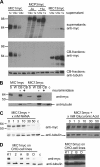Members of a novel protein family containing microneme adhesive repeat domains act as sialic acid-binding lectins during host cell invasion by apicomplexan parasites
- PMID: 19901027
- PMCID: PMC2804363
- DOI: 10.1074/jbc.M109.060988
Members of a novel protein family containing microneme adhesive repeat domains act as sialic acid-binding lectins during host cell invasion by apicomplexan parasites
Abstract
Numerous intracellular pathogens exploit cell surface glycoconjugates for host cell recognition and entry. Unlike bacteria and viruses, Toxoplasma gondii and other parasites of the phylum Apicomplexa actively invade host cells, and this process critically depends on adhesins (microneme proteins) released onto the parasite surface from intracellular organelles called micronemes (MIC). The microneme adhesive repeat (MAR) domain of T. gondii MIC1 (TgMIC1) recognizes sialic acid (Sia), a key determinant on the host cell surface for invasion by this pathogen. By complementation and invasion assays, we demonstrate that TgMIC1 is one important player in Sia-dependent invasion and that another novel Sia-binding lectin, designated TgMIC13, is also involved. Using BLAST searches, we identify a family of MAR-containing proteins in enteroparasitic coccidians, a subclass of apicomplexans, including T. gondii, suggesting that all these parasites exploit sialylated glycoconjugates on host cells as determinants for enteric invasion. Furthermore, this protein family might provide a basis for the broad host cell range observed for coccidians that form tissue cysts during chronic infection. Carbohydrate microarray analyses, corroborated by structural considerations, show that TgMIC13, TgMIC1, and its homologue Neospora caninum MIC1 (NcMIC1) share a preference for alpha2-3- over alpha2-6-linked sialyl-N-acetyllactosamine sequences. However, the three lectins also display differences in binding preferences. Intense binding of TgMIC13 to alpha2-9-linked disialyl sequence reported on embryonal cells and relatively strong binding to 4-O-acetylated-Sia found on gut epithelium and binding of NcMIC1 to 6'sulfo-sialyl Lewis(x) might have implications for tissue tropism.
Figures







Similar articles
-
Detailed insights from microarray and crystallographic studies into carbohydrate recognition by microneme protein 1 (MIC1) of Toxoplasma gondii.Protein Sci. 2009 Sep;18(9):1935-47. doi: 10.1002/pro.204. Protein Sci. 2009. PMID: 19593815 Free PMC article.
-
Identification of a Neospora caninum microneme protein (NcMIC1) which interacts with sulfated host cell surface glycosaminoglycans.Infect Immun. 2002 Jun;70(6):3187-98. doi: 10.1128/IAI.70.6.3187-3198.2002. Infect Immun. 2002. PMID: 12011014 Free PMC article.
-
Galactose recognition by the apicomplexan parasite Toxoplasma gondii.J Biol Chem. 2012 May 11;287(20):16720-33. doi: 10.1074/jbc.M111.325928. Epub 2012 Mar 7. J Biol Chem. 2012. PMID: 22399295 Free PMC article.
-
Microneme proteins: structural and functional requirements to promote adhesion and invasion by the apicomplexan parasite Toxoplasma gondii.Int J Parasitol. 2001 Oct;31(12):1293-302. doi: 10.1016/s0020-7519(01)00257-0. Int J Parasitol. 2001. PMID: 11566297 Review.
-
Toxoplasma gondii: microneme protein MIC2.Int J Biochem Cell Biol. 2005 Nov;37(11):2266-72. doi: 10.1016/j.biocel.2005.06.006. Int J Biochem Cell Biol. 2005. PMID: 16084754 Review.
Cited by
-
Identification and molecular characterization of microneme 5 of Eimeria acervulina.PLoS One. 2014 Dec 22;9(12):e115411. doi: 10.1371/journal.pone.0115411. eCollection 2014. PLoS One. 2014. PMID: 25531898 Free PMC article.
-
Proteomic analysis of fractionated Toxoplasma oocysts reveals clues to their environmental resistance.PLoS One. 2012;7(1):e29955. doi: 10.1371/journal.pone.0029955. Epub 2012 Jan 18. PLoS One. 2012. PMID: 22279555 Free PMC article.
-
Evaluation of the immune protective effects of rEmMIC2 and rEmMIC3 from Eimeria magna in rabbits.Parasitol Res. 2023 Feb;122(2):661-669. doi: 10.1007/s00436-022-07774-3. Epub 2022 Dec 27. Parasitol Res. 2023. PMID: 36572833 Free PMC article.
-
Micronemal protein 13 contributes to the optimal growth of Toxoplasma gondii under stress conditions.Parasitol Res. 2019 Mar;118(3):935-944. doi: 10.1007/s00436-018-06197-3. Epub 2019 Jan 11. Parasitol Res. 2019. PMID: 30635773
-
Global analysis of apicomplexan protein S-acyl transferases reveals an enzyme essential for invasion.Traffic. 2013 Aug;14(8):895-911. doi: 10.1111/tra.12081. Epub 2013 May 29. Traffic. 2013. PMID: 23638681 Free PMC article.
References
-
- Takabatake N., Okamura M., Yokoyama N., Ikehara Y., Akimitsu N., Arimitsu N., Hamamoto H., Sekimizu K., Suzuki H., Igarashi I. (2007) Vet. Parasitol. 148, 93–101 - PubMed
Publication types
MeSH terms
Substances
Grants and funding
LinkOut - more resources
Full Text Sources
Other Literature Sources
Research Materials

